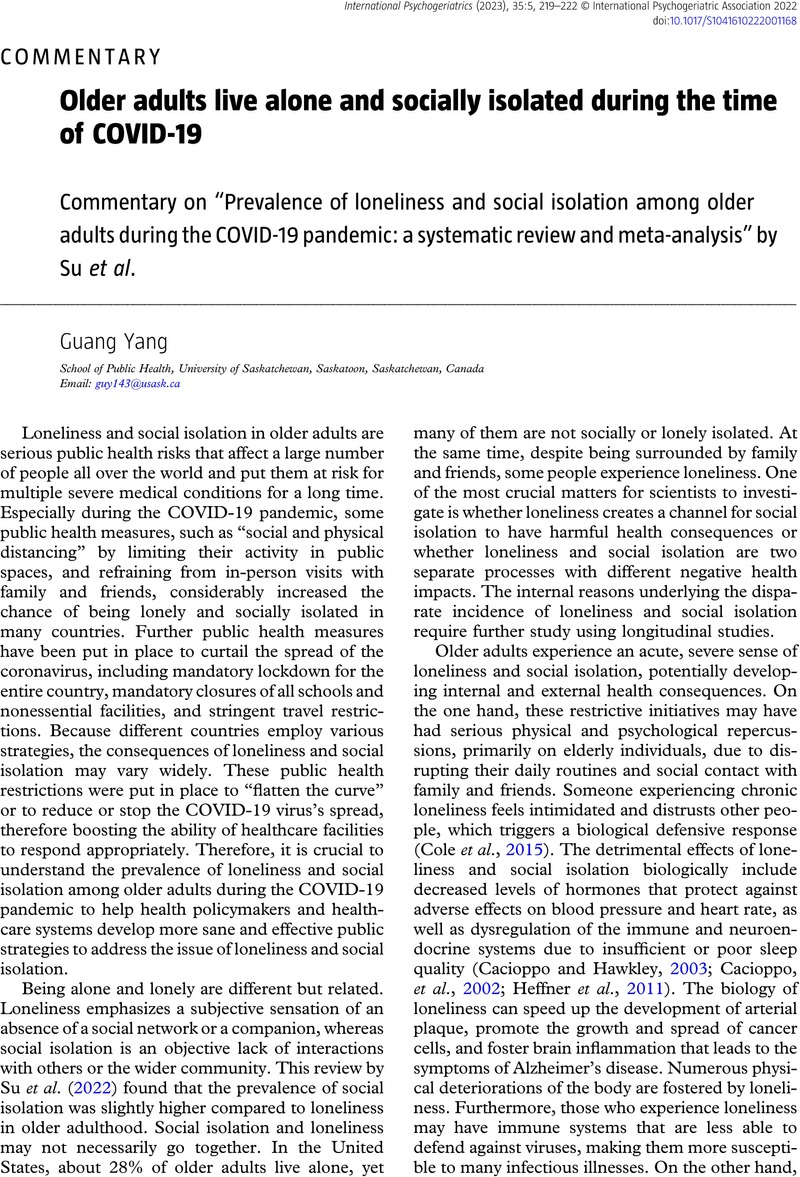No CrossRef data available.
Article contents
Older adults live alone and socially isolated during the time of COVID-19
Commentary on “Prevalence of loneliness and social isolation among older adults during the COVID-19 pandemic: a systematic review and meta-analysis” by Su et al.
Published online by Cambridge University Press: 06 December 2022
Abstract
An abstract is not available for this content so a preview has been provided. Please use the Get access link above for information on how to access this content.

- Type
- Commentary
- Information
- Copyright
- © International Psychogeriatric Association 2022
References
Barber, S. J., Opitz, P. C., Martins, B., Sakaki, M. and Mather, M. (2016). Thinking about a limited future enhances the positivity of younger and older adults’ recall: support for socioemotional selectivity theory. Memory & Cognition, 44, 869–882.CrossRefGoogle ScholarPubMed
Barreto, M., Victor, C., Hammond, C., Eccles, A., Richins, M. T., Qualter, P. (2021). Loneliness around the world: age, gender, and cultural differences in loneliness. Personality and Individual Differences, 169, 110066.CrossRefGoogle ScholarPubMed
Boyd, M. et al. (2021). Lonely in a crowd: loneliness in New Zealand retirement village residents. International Psychogeriatrics, 33, 481–493.CrossRefGoogle Scholar
Burnette, D., Ye, X., Cheng, Z. and Ruan, H. (2021). Living alone, social cohesion, and quality of life among older adults in rural and urban China: a conditional process analysis. International Psychogeriatrics, 33, 469–479.CrossRefGoogle Scholar
Cacioppo, J. T. et al. (2002). Do lonely days invade the nights? Potential social modulation of sleep efficiency. Psychological Science, 13, 384–387.CrossRefGoogle ScholarPubMed
Cacioppo, J. T. and Hawkley, L. C. (2003). Social isolation and health, with an emphasis on underlying mechanisms. Perspectives in Biology and Medicine, 46, S39–S52.CrossRefGoogle ScholarPubMed
Cohn-Schwartz, E., Levinsky, M. and Litwin, H. (2021). Social network type and subsequent cognitive health among older Europeans. International Psychogeriatrics, 33, 495–504.CrossRefGoogle ScholarPubMed
Cole, S. W., Capitanio, J. P., Chun, K., Arevalo, J. M. G., Ma, J., Cacioppo, J. T. (2015). Myeloid differentiation architecture of leukocyte transcriptome dynamics in perceived social isolation. Proceedings of the National Academy of Sciences, 112, 15142–15147.Google ScholarPubMed
Fässberg, M. M. et al. (2012). A systematic review of social factors and suicidal behavior in older adulthood. International Journal of Environmental Research and Public Health, 9, 722–745.CrossRefGoogle ScholarPubMed
Hawkley, L. C. and Cacioppo, J. T. (2010). Loneliness matters: a theoretical and empirical review of consequences and mechanisms. Annals of Behavioral Medicine, 40, 218–227.CrossRefGoogle ScholarPubMed
Heffner, K. L., Waring, M. E., Roberts, M. B., Eaton, C. B. and Gramling, R. (2011). Social isolation, C-reactive protein, and coronary heart disease mortality among community-dwelling adults. Social Science & Medicine, 72, 1482–1488.CrossRefGoogle ScholarPubMed
Karimi, M., van der Zwaan, L., Islam, K., van Genabeek, J., Mölken, M. R.-V. (2021). Evaluating complex health and social care program using multi-criteria decision analysis: a case study of “Better Together in Amsterdam North”. Value Health, 24, 966–975.CrossRefGoogle Scholar
Khan, M. S. R. and Kadoya, Y. (2021). Loneliness during the COVID-19 pandemic: a comparison between older and younger people. International Journal of Environmental Research and Public Health, 18, 7871.Google ScholarPubMed
Leigh-Hunt, N. et al. (2017). An overview of systematic reviews on the public health consequences of social isolation and loneliness. Public Health, 152, 157–171.CrossRefGoogle ScholarPubMed
Lim, M. H., Holt-Lunstad, J. and Badcock, J. C. (2020). Loneliness: contemporary insights into causes, correlates, and consequences. Social Psychiatry and Psychiatric Epidemiology, 55, 789–791.CrossRefGoogle ScholarPubMed
Lutzman, M., Sommerfeld, E. and Ben-David, S. (2021). Loneliness and social integration as mediators between physical pain and suicidal ideation among elderly men. International Psychogeriatrics, 33, 453–459.CrossRefGoogle ScholarPubMed
McCausland, D., McCallion, P., Carroll, R. and McCarron, M. (2021). The nature and quality of friendship for older adults with an intellectual disability in Ireland. Journal of Applied Research in Intellectual Disabilities, 34, 763–776.CrossRefGoogle ScholarPubMed
Ogińska-Bulik, N. and Michalska, P. (2021). Psychological resilience and secondary traumatic stress in nurses working with terminally ill patients—the mediating role of job burnout. Psychological Services, 18, 398–405.Google ScholarPubMed
Su, Y., Rao, W., Li, M., Caron, G., D’Arcy, C. and Meng, X. (2022). Prevalence of loneliness and social isolation among older adults during the COVID-19 pandemic: a systematic review and meta-analysis. International Psychogeriatrics, 35, 229–241.Google Scholar
Wu, X. S. et al. (2016). Prevalence of Internet addiction and its association with social support and other related factors among adolescents in China. Journal of Adolescence, 52, 103–111.CrossRefGoogle ScholarPubMed




